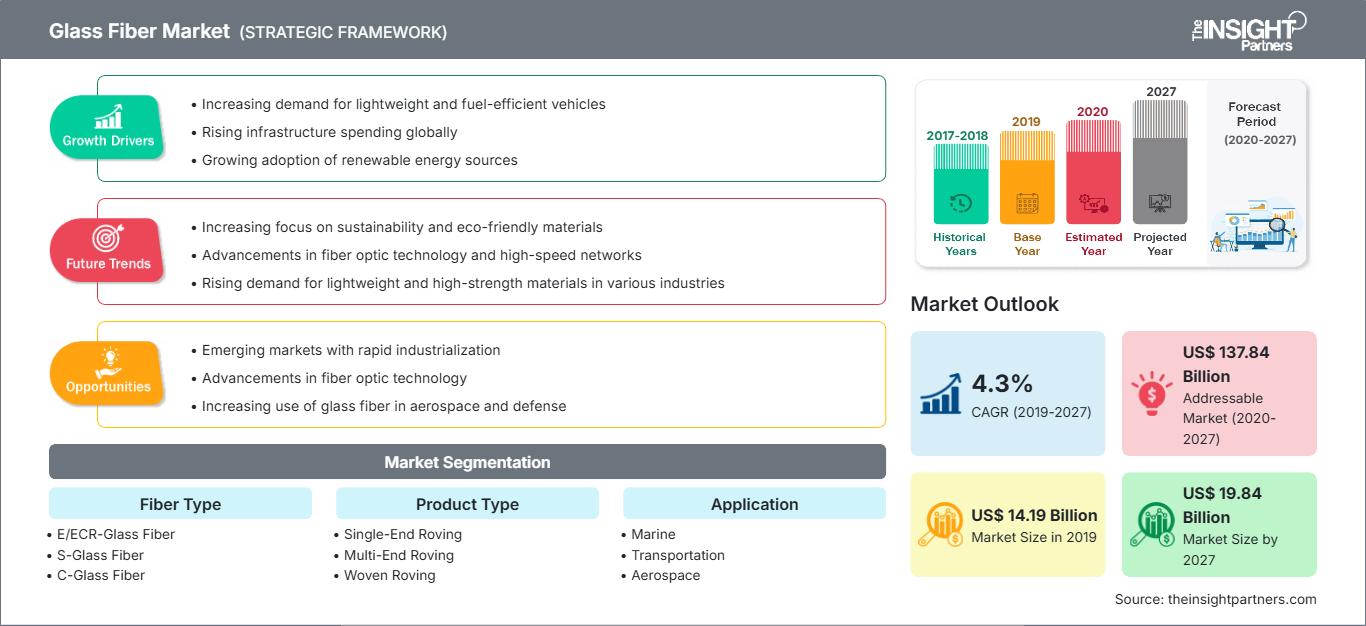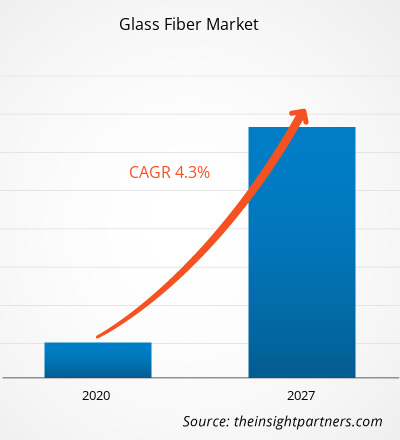ガラス繊維市場は2019年に141億9,355万米ドルと評価され、2020年から2027年にかけて年平均成長率4.3%で成長し、2027年には198億3,762万米ドルに達すると予測されています。
ガラス繊維は、非常に細いガラスのフィラメントを糸に組み合わせて織物に織り込んだ素材です。シリカ(SiO2)、石灰石、ソーダ灰を3段階の炉で混合・溶融し、溶融ガラスを前炉底のブッシングから押し出し、フィラメントを水で冷却することで製造されます。ガラス繊維は、耐食性に優れ、剛性と強度が高く、引張強度が高く、高温耐性と耐久性に優れています。これらの繊維は、自動車、建設、海洋、風力エネルギー、航空宇宙および防衛などの最終用途産業で使用されています。しかし、製造プロセスの課題、新技術のコスト集約型の性質、およびガラス繊維の低い利益率が、市場の成長を制限しています。
2019年、アジア太平洋地域は世界のガラス繊維市場で最大のシェアを占めました。今後数年間、APACはガラス繊維の最速の成長市場になると予想されています。輸送、建設、電気および電子、航空宇宙、およびその他の産業の成長に伴い、この地域のガラス繊維の需要が大幅に増加しています。建設業界はガラス繊維の主要な消費者の1つです。インドや中国などの新興市場における急速なインフラ開発は、高度なガラス繊維の需要を促進しています。たとえば、インド政府は住宅および交通インフラの改善に多大な努力を払ってきました。インド工業貿易振興局(DPIIT)によると、2000年4月から2020年9月までの建設開発セクターおよびインフラ活動への外国直接投資(FDI)は、それぞれ257億8000万米ドルと172億2000万米ドルでした。インフラ開発への継続的な投資は、ガラス繊維の消費量を大幅に押し上げるでしょう。さらに、ガラス繊維は海洋、航空エネルギー、消費財産業でも使用されており、これらの産業も政府からの多額の投資を受けており、この地域のガラス繊維市場の成長を支えています。
COVID-19は、2019年12月に武漢(中国)で最初に始まり、それ以来、世界中に急速に広がっています。2021年3月の時点で、米国、インド、ブラジル、ロシア、フランス、英国、トルコ、イタリア、スペインは、確認された症例数と報告された死亡者数で最も影響を受けた国の一部です。 COVID-19パンデミックは、ロックダウン、渡航禁止、事業停止などにより、様々な国の経済と産業に影響を及ぼしています。さらに、欧州、アジア、北米諸国による世界的な渡航禁止措置は、ビジネスコラボレーションやパートナーシップの機会にも影響を与えています。これらの要因はすべて、化学・素材業界に悪影響を及ぼし、ガラス繊維市場の成長を抑制する要因となることが予想されます。
要件に合わせてレポートをカスタマイズ
レポートの一部、国レベルの分析、Excelデータパックなどを含め、スタートアップ&大学向けに特別オファーや割引もご利用いただけます(無償)
ガラス繊維市場: 戦略的洞察

-
このレポートの主要な市場動向を入手してください。この無料サンプルには、市場動向から見積もりや予測に至るまでのデータ分析が含まれます。
ガラス繊維は、建設分野において断熱材、表面コーティング材、外装材、屋根材などの原材料として使用されています。ガラス繊維は安価であり、剛性、柔軟性、透明性、耐薬品性、不活性といった機械的特性は、ポリマーや炭素繊維などの他の繊維とほぼ同等です。ガラス繊維はガラス繊維強化コンクリートに使用され、壁、暖炉の周囲、基礎、外装材、洗面台、コンクリート製カウンタートップなどの建設に利用されています。主に建物の外装壁パネルや建築用プレキャストコンクリートに使用されています。ガラス繊維は主要な担体として機能し、高い引張強度を提供し、コンクリートに柔軟性とひび割れ耐性をもたらします。耐アルカリ性ガラス繊維(ARGF)は建設資材として広く使用されています。ARGFはコンクリートの引張強度、曲げ靭性、破壊係数、耐摩耗性を大幅に向上させます。このようなコンクリートはひび割れ防止に使用され、建設分野で幅広い用途が見込まれています。
世界の建設業界の急速な発展により、ガラス繊維の需要が増加すると予想されています。米国などの先進国における住宅の新築がガラス繊維の需要を支えています。例えば、米国国勢調査局によると、2020年3月、米国で建築許可が下りた住宅の総数は年間1,353,000戸で、2019年3月比5%増でした。これとは別に、中国やインドなどの新興市場の力強い経済成長は、堅調なインフラ整備をもたらしています。これらの国では、新築、既存構造物の保守・修理、改修、プレカットの現場での組み立て、仮設建物の建設、エレベーターやエスカレーターなどの特殊な建築設備の設置が増加しています。これらすべての要因により、建設業界でガラス繊維の一貫した需要が生まれると予想されています。
繊維タイプの洞察
繊維タイプに基づいて、世界のガラス繊維市場は
E / ECRガラス繊維、Sガラス繊維、Cガラス繊維、その他に分類されます。 E / ECRガラス繊維セグメントは、2019年に最高の市場シェアでガラス繊維市場をリードしました。 Eガラスは電子ガラスであり、高強度、優れた絶縁性、耐水性、耐腐食性などの特性を備えた主要なタイプのガラス繊維の1つです。 Eガラス繊維は、コストが手頃で弾性率が低く、他のガラス繊維よりも早く開発されたため、すべての繊維強化材および繊維強化複合材料の中で最も広く使用されています。 一方、ECRガラスはEガラスに似ていますが、フッ素とホウ素が含まれていません。 ECRガラス繊維は環境に優しく、耐酸性、耐水性、耐熱性、耐アルカリ性に優れています。さらに、ECRガラス繊維は優れた誘電強度、低い電気リーク、高い表面抵抗を備えています。2005年1月からASTM-D578-1999規格に基づいて製造されているECRガラス繊維は、透明FRP(繊維強化プラスチック)パネル用途を除くすべての電子ガラス用途に適しています。自動車、電子機器、電化製品におけるE/ECRガラス繊維の広範な使用は、予測期間中のセグメント成長を牽引すると予想されます。製品タイプに関する洞察
製品タイプに基づいて、世界のガラス繊維市場は
シングルエンドロービング、マルチエンドロービング、織りロービング、その他に分類されます。 2019年、その他セグメントが世界のガラス繊維市場を牽引しました。その他セグメントには、ファブリック、CSM、CFM、DUCS、CS、OptiSprayロービング、Cem-FILロービング、ダイレクトロービングなどが含まれます。OptiSprayロービングは、製品のパフォーマンスを向上させながら時間と樹脂を節約したい製造業者にとって魅力的なソリューションです。Cem-FILロービングは、同時スプレー法によるガラス繊維強化コンクリート複合材の製造に使用するために製造された、耐アルカリ性ガラス繊維集成ロービングです。Cem-FILロービングは、耐アルカリ性ガラス、良好な巻き戻し、容易な切断、高い分割効率などの利点があり、複雑なプロファイルや優れた機械的性能に最適です。Owens Corningなどのメーカーは、OptiSpray Fロービング、Cem-FILRoving 5325、Cem-FILRoving 62.4、Cem-FILロービング62/70を提供しています。 Saint-Gobain Vetrotexは、Eガラス製のスプライスフリーのシングルエンドロービングであるダイレクトロービングを提供しており、さまざまな繊維技術に適しています。アプリケーションインサイト
アプリケーションに基づいて、世界のガラス繊維市場は、
海洋、輸送、航空宇宙、建設、電気および電子、消費財、その他に分類されます。
輸送セグメントは、2019年に世界のガラス繊維市場をリードしました。ガラス繊維は、ルーフパネル、ドア、窓、冷却ベンチレーター、荷物入れ、座席、ヘッドレストのバックパネルなど、輸送業界で使用されています。ガラス繊維は強度対重量比が高く、これは自動車製造に不可欠な要素です。これらの要因は、予測期間中に輸送業界のガラス繊維市場の成長を促進すると予想されます。製造プロセスの洞察
製造プロセスに基づいて、世界のガラス繊維市場は、ハンドレイアップ、スプレーアップ、プリプレグ レイアップ、射出成形、圧縮成形、樹脂注入、その他に分類されます。その他セグメントは、2019年に世界のガラス繊維市場をリードしました。その他セグメントには、プルトルージョン、遠心鋳造、ハイブリッド射出成形/熱成形などが含まれます。プルトルージョンは低コストでシンプルな連続プロセスであり、ガラス繊維とポリエステル樹脂で数十年にわたって使用されてきました。それでも、近年、このプロセスは高度な複合材料アプリケーションにも応用されています。プルトルージョンでは、通常、後処理を必要としない滑らかな完成部品が生成されます。遠心注型法では、エポキシ樹脂またはビニルエステル樹脂を 150G の遠心回転金型に注入し、金型の内面に巻き付けられた織物に浸透させます。
ガラス繊維市場で活動している主要な市場プレーヤーとしては、Johns Manville、Jushi Co., Ltd.、Chongqing Polycomp International Corp. (CPIC)、Goa Glass Fiber Ltd、Nippon Electric Glass Co. Ltd、Saint-Gobain Vetrotex、Sichuan Weibo New Material Group Co., Ltd.、Taishan Fiberglass Inc、Taiwan Glass Group、および Owens Corning などがあります。これらの企業は世界中に製品を提供しており、より広い顧客ベースに対応するのに役立っています。市場の主要プレーヤーは、顧客の要件を満たす高品質で革新的な製品の開発に重点を置いています。過去数年間、市場で活動している企業は、ガラス繊維市場に関連する計り知れない可能性を認識し、合併や買収などの戦略に深く関与してきました。買収と製品発売。例えば、2020年には、Jushiは軽量風力タービンブレードの開発を促進するために、E9超高弾性ガラス繊維を発売しました。
ガラス繊維市場
The Insight Partnersのアナリストは、予測期間を通じてガラスファイバー市場に影響を与える地域的な動向と要因を詳細に解説しています。このセクションでは、北米、ヨーロッパ、アジア太平洋、中東・アフリカ、中南米におけるガラスファイバー市場のセグメントと地域についても解説しています。
ガラス繊維市場レポートの範囲
| レポート属性 | 詳細 |
|---|---|
| の市場規模 2019 | US$ 14.19 Billion |
| 市場規模別 2027 | US$ 19.84 Billion |
| 世界的なCAGR (2019 - 2027) | 4.3% |
| 過去データ | 2017-2018 |
| 予測期間 | 2020-2027 |
| 対象セグメント |
By ファイバータイプ
|
| 対象地域と国 |
北米
|
| 市場リーダーと主要企業の概要 |
|
ガラス繊維市場のプレーヤー密度:ビジネスダイナミクスへの影響を理解する
グラスファイバー市場は、消費者の嗜好の変化、技術の進歩、製品の利点に対する認知度の高まりといった要因により、エンドユーザーの需要が高まり、急速に成長しています。需要の増加に伴い、企業は製品ラインナップの拡充、消費者ニーズへの対応、そして新たなトレンドの活用を進めており、これが市場の成長をさらに加速させています。

- 入手 ガラス繊維市場 主要プレーヤーの概要
- 世界のガラス繊維市場における進歩的な業界動向。企業が効果的な長期戦略を策定するのに役立ちます
- 先進国と発展途上国で採用されているビジネス成長戦略
- 2017年から2027年までの世界のガラス繊維市場の定量分析
- さまざまな業界におけるガラス繊維の需要の推定
- 市場で事業を展開しているバイヤーとサプライヤーの有効性を示すPEST分析。市場の成長を予測するために
- 競争の激しい市場状況とガラス繊維の需要を理解するための最近の動向
- ガラス繊維市場の成長を促進および抑制する要因と相まって、市場の動向と展望
- 世界のガラス繊維市場の成長に関する商業的関心を支える戦略を理解することによる意思決定プロセス
- 市場のさまざまなノードにおけるガラス繊維市場の規模
- 世界のガラス繊維市場の詳細な概要とセグメンテーション、および業界におけるそのダイナミクス
- ガラス繊維有望な成長機会のある様々な地域の市場規模
世界のガラス繊維市場(繊維タイプ別)
- E/ECR-ガラス繊維
- S-ガラス繊維
- C-ガラス繊維
- その他
世界のガラス繊維市場(製品タイプ別)
- シングルエンドロービング
- マルチエンドロービング
- 織りロービング
- その他
世界のガラス繊維市場(用途別)
- 海洋
- 輸送
- 航空宇宙
- 建設
- 電気・電子
- 消費財
- その他
世界のガラス繊維市場(製造プロセス別)
- ハンドレイアップ
- スプレーアップ
- プリプレグ・レイアップ
- 射出成形
- 圧縮成形
- 樹脂注入
- その他
会社概要
- 重慶ポリコンプ・インターナショナル・コーポレーション(CPIC)
- ジョンズ・マンビル
- 中国樹脂有限公司
- 日本電気硝子株式会社
- オーウェンス・コーニング
- サンゴバンSA
- 四川微博新素材集団有限公司
- 台山ガラス株式会社(CTG)
- 台湾ガラスグループ
- ゴア・グラス・ファイバー・リミテッド
- 過去2年間の分析、基準年、CAGRによる予測(7年間)
- PEST分析とSWOT分析
- 市場規模価値/数量 - 世界、地域、国
- 業界と競争環境
- Excel データセット
最新レポート
関連レポート
お客様の声
購入理由
- 情報に基づいた意思決定
- 市場動向の理解
- 競合分析
- 顧客インサイト
- 市場予測
- リスク軽減
- 戦略計画
- 投資の正当性
- 新興市場の特定
- マーケティング戦略の強化
- 業務効率の向上
- 規制動向への対応






















 無料サンプルを入手 - ガラス繊維市場
無料サンプルを入手 - ガラス繊維市場